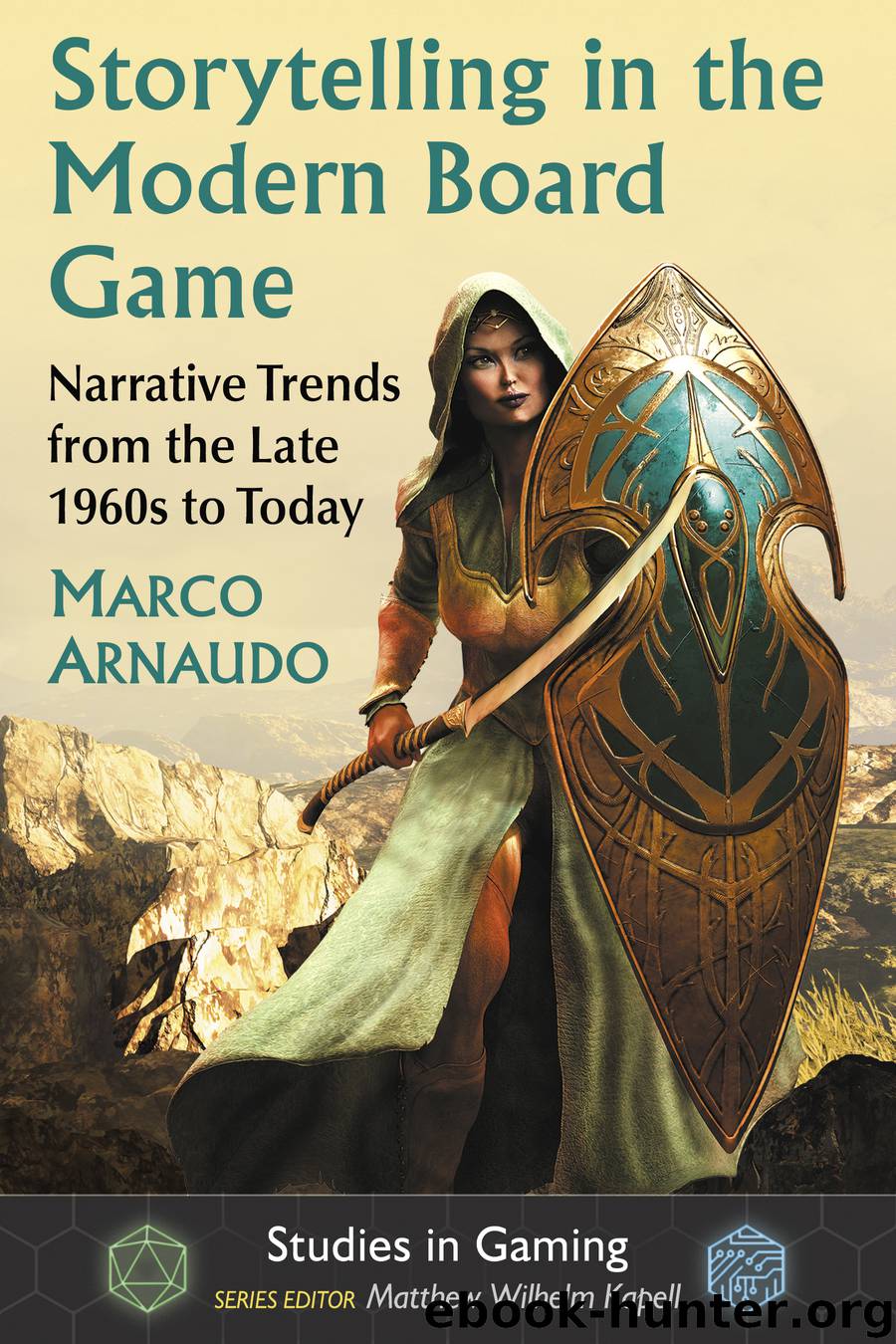Storytelling in the Modern Board Game by Marco Arnaudo

Author:Marco Arnaudo
Language: eng
Format: epub
Publisher: McFarland
Published: 2018-08-27T16:00:00+00:00
By alternating random and planned movement on a prearranged string of panels, the Adventure Charts ensure variety and unpredictability while also retaining a strong sense of progression and causation. Player agency also can have a role if the active player possesses the right cards and decides to play them. Randomness therefore becomes something that often can be chosen, rather than passively suffered in every instance like in DungeonQuest or Talisman.
Another intersection of gaming, comics, and adventure, is in the solitaire game Chainsaw Warrior by Stephen Hand, published by Games Workshop in 1987. The game comes with a comic book that introduces the background story and the mission, and helps create the proper atmosphere.4 The player controls a bionically enhanced soldier who must fight his way through a building swarming with transdimensional zombies. The locations and events in the game are constructed through the use of a deck of cards that show on one side the hero’s current location as seen from the point of view of the protagonist, and on the other have a description or illustration of what the hero has encountered. Shuffled randomly and drawn one at a time, these highly visual cards are meant to create the illusion of an intricate net of passages that changes in every game. This way, the deck works almost as an extension of the comic book, each card virtually becoming a new panel in the story. The narrative connection is even more evident when, after reading the designer’s notes, we find that the structure of the game was inspired by that of the gamebooks that were popular at the time (rulebook, 19).
While the examples above show how adventure games can benefit from the combination of board-based actions and a textual apparatus, such a synergy is nowhere as productive as in board games belonging to the mystery genre. The classic game Clue (Parker Brothers, 1949) and later mystery games like Murder on the Orient Express (Ideal, 1967), Whodunit (1972), The Mysteries of Peking (Milton Bradley, 1987), Inkognito (Ares, 1988), Mystery Express (Days of Wonder, 2010), Outfoxed (Gamewright, 2014), and scores of others, all rely on a fairly abstract and mechanical system.5 In these games one does not solve a case by finding, selecting, and connecting clues logically, and taking psychology into account, like in the real world; rather, the players get to cross off options from a finite list as a reward for performing certain actions (like reaching a specific space on the board). For this reason, these designs convey little more theme and story than games of abstract logic like Mastermind (Pressman, 1971).
The board game 221B Baker St, designed by Jay Moriarty and published by Antler Productions in 1975, made an early attempt to inject a higher sense of verisimilitude in its mystery-based proceedings, and it did so precisely by adding a paragraph system. The game comes with twenty case cards, each containing the description of a mystery presented in narrative form, as a true micro-story. This format does not isolate
Download
This site does not store any files on its server. We only index and link to content provided by other sites. Please contact the content providers to delete copyright contents if any and email us, we'll remove relevant links or contents immediately.
| Fantasy | Gaming |
| Science Fiction | Writing |
Arthas: Rise of the Lich King by Christie Golden(2012)
World of Warcraft Chronicle Volume 3 by Blizzard Entertainment(1697)
Pillars of Eternity Guidebook by Obsidian Entertainment(1611)
1628927445Game by Unknown(1513)
Drizzt - 01 - Homeland by R.A. Salvatore(1479)
The Ultimate Player's Guide to Minecraft by Stephen O'Brien(1476)
Dark Elf 02 - Exile by R. A. Salvatore(1440)
Road Games by Road Games(1401)
Playing by the Rules(1372)
Salvatore 1 - The Crystal Shard by Salvatore R. A(1363)
Starcraft by Blizzard Entertainment(1357)
Dark Elf Trilogy 01 - Homeland by R.A. Salvatore(1335)
Binging with Babish by Andrew Rea(1315)
Gaslands by Mike Hutchinson(1305)
The Host by The Host(1289)
The Cthulhu Wars by Kenneth Hite(1264)
The Halfling's Gem by Salvatore R. A(1258)
Slaves to Darkness 03 (The Heart of Chaos) by Warhammer(1219)
The Book of Fantasy by Unknown(1123)
